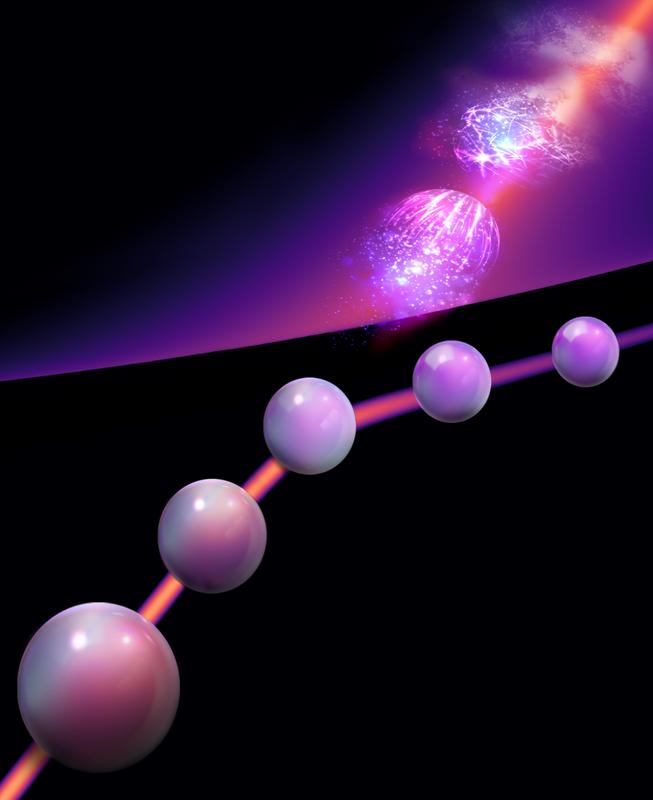Immortal quantum particles: the cycle of decay and rebirth

Strong quantum interactions prevent quasiparticles from decay. K. Verresen / TUM
As the saying goes, nothing lasts forever. The laws of physics confirm this: on our planet, all processes increase entropy, thus molecular disorder. For example, a broken glass would never put itself back together again.
Theoretical physicists at the Technical University of Munich (TUM) and the Max Planck Institute for the Physics of Complex Systems have discovered that things which seem inconceivable in the everyday world are possible on a microscopic level.
“Until now, the assumption was that quasiparticles in interacting quantum systems decay after a certain time. We now know that the opposite is the case: strong interactions can even stop decay entirely,” explains Frank Pollmann, Professor for Theoretical Solid-State Physics at the TUM. Collective lattice vibrations in crystals, so-called phonons, are one example of such quasiparticles.
The concept of quasiparticles was coined by the physicist and Nobel prize winner Lev Davidovich Landau. He used it to describe collective states of lots of particles or rather their interactions due to electrical or magnetic forces. Due to this interaction, several particles act like one single one.
Numeric methods open up new perspectives
Up until now, it wasn’t known in detail which processes influence the fate of these quasiparticles in interacting systems,” says Pollmann. “It is only now that we possess numerical methods with which we can calculate complex interactions as well as computers with a performance which is high enough to solve these equations.”
“The result of the elaborate simulation: admittedly, quasiparticles do decay, however new, identical particle entities emerge from the debris,” says the lead author, Ruben Verresen. “If this decay proceeds very quickly, an inverse reaction will occur after a certain time and the debris will converge again. This process can recur endlessly and a sustained oscillation between decay and rebirth emerges.”
From a physical point of view, this oscillation is a wave which is transformed into matter, which, according to quantum mechanical wave-particle duality, is possible. Therefore, the immortal quasiparticles do not transgress the second law of thermodynamics. Their entropy remains constant, decay has been stopped.
The reality check
The discovery also explains phenomena which were baffling until now. Experimental physicists had measured that the magnetic compound Ba3CoSB2O9 is astonishingly stable. Magnetic quasiparticles, magnons, are responsible for it. Other quasiparticles, rotons, ensure that helium which is a gas on the earth’s surface becomes a liquid at absolute zero which can flow unrestricted.
“Our work is purely basic research,“ emphasizes Pollmann. However, it is perfectly possible that one day the results will even allow for applications, for example the construction of durable data memories for future quantum computers.
More information:
The research work was funded by the European Research Council (ERC) and the German Research Foundation (DFG) within the framework of the [Collaborative Research Center] SFB 1143, the Research Unit FOR1807 as well as the cluster of excellence Nanosystems Initiative Munich (NIM). Work will be carried on in the cluster of excellence Munich Center for Quantum Science and Technology (MCQST).
Prof. Dr. Frank Pollmann
Professorship for Theoretical and Solid State Physics
James-Franck-Str. 1
85748 Garching
Tel.: +49 89 289 53760
e-mail: frank.pollmann@tum.de
Web: http://tccm.pks.mpg.de
Ruben Verresen, Roderich Moessner & Frank Pollmann
Avoided quasiparticle decay from strong quantum interactions
nature physics, May 27, 2019
DOI: 10.1038/s41567-019-0535-3
https://www.nature.com/articles/s41567-019-0535-3
https://www.tum.de/nc/en/about-tum/news/press-releases/details/35492/
https://mediatum.ub.tum.de/1506313
Media Contact
All latest news from the category: Physics and Astronomy
This area deals with the fundamental laws and building blocks of nature and how they interact, the properties and the behavior of matter, and research into space and time and their structures.
innovations-report provides in-depth reports and articles on subjects such as astrophysics, laser technologies, nuclear, quantum, particle and solid-state physics, nanotechnologies, planetary research and findings (Mars, Venus) and developments related to the Hubble Telescope.
Newest articles

Properties of new materials for microchips
… can now be measured well. Reseachers of Delft University of Technology demonstrated measuring performance properties of ultrathin silicon membranes. Making ever smaller and more powerful chips requires new ultrathin…

Floating solar’s potential
… to support sustainable development by addressing climate, water, and energy goals holistically. A new study published this week in Nature Energy raises the potential for floating solar photovoltaics (FPV)…

Skyrmions move at record speeds
… a step towards the computing of the future. An international research team led by scientists from the CNRS1 has discovered that the magnetic nanobubbles2 known as skyrmions can be…





















